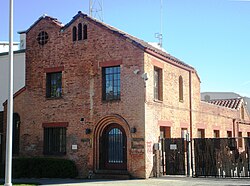KCET Studios
| KCET Studios | |
|---|---|

Administration building erected by Charles Ray in 1922
|
|
| Location | 4401 Sunset Boulevard, Hollywood, California |
| Built | 1912 |
| Governing body | private |
| Designated | 1978 |
| Reference no. | 198 |
The KCET Studios, located at 4401 Sunset Boulevard in Hollywood, California is the longest continuously-producing studio in Hollywood. Since its establishment in 1912, the studios located at the site have been the home of motion picture producers, including Lubin, Essanay, Willis and Inglis, J.D. Hampton, Charles Ray, Ralph Like, Monogram Pictures, Allied Artists, and ColorVision. Since 1970, it has been the home of public television station KCET, but in April 2011 KCET announced that it had sold the facility to the Church of Scientology.
In 1912, Siegmund Lubin, a film producer from Philadelphia, built the first film studio on the site of what is now KCET Studios. Lubin's company, called Lubin Manufacturing Company, produced educational films at the site, including "An Alligator Farm" (1912) and "An Ostrich and Pigeon Farm." In 1913, Lubin sold the studio to the Chicago-based Essanay Film Company. Essanay produced 20 one-reel Westerns before selling the site to the Kalem Company. Kalem began operating at the lot in late 1913, and Marshall Neilan began working at the site in the Spring of 1914. The "Ham and Bud" comedy series was shot there from late 1914 through February 1917. At that time, Kalem relocated to Glendale and abandoned the Fleming Street studios. In 1917, Willis and Inglis acquired the studio and rented space for use by independent producers. Wallis and Inglis build a 65-foot (20 m) by 11-foot (3.4 m) outdoor stage and a 50-foot (15 m) by 100-foot (30 m) indoor stage. During this time, The Marine Film Corporation filmed "Lorelei of the Sea" at the studios, and comedian Fay Tincher made a series of two-reel comedies there.
In August 1918, Jesse D. Hampton began renting space from Willis and Inglis. And in March 1919, Willis and Inglis built another station that became known as Hampton Studio. In April 1919, a trade magazine reported: "The entire frontage along Fleming Street, heretofore adorned by a blank wall, is now occupied with a long row of offices filled with workers and other functionaries necessary to the operation of the big place." Hampton made more than 25 films at the site from 1918 to 1920.
...
Wikipedia
